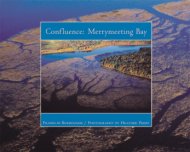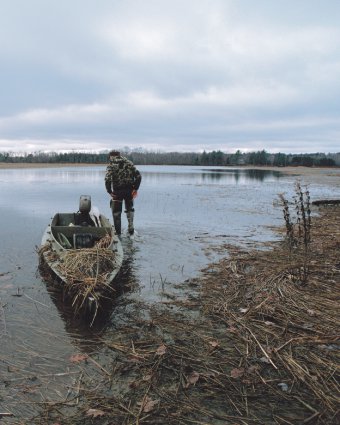
Book Review
By Lee Bumsted
A confluence of rivers claims one man's heart
Printer Friendly Page
 |
Confluence: Photographs by Heather Perry |
 |
PHOTO: HEATHER PERRY |
Merrymeeting Bay sits 16 miles upriver from the Gulf of Maine. That's the first sign that this is an unusual body of water. To a casual observer, it might appear to be another landlocked Maine lake, were it not for its five-foot tidal variation. Two major rivers, the Androscoggin and the Kennebec, meet there, along with four smaller ones. Their merged waters squeeze through the Chops, a narrow bedrock constriction or passageway, then flow as the Kennebec River past the city of Bath and on to the Atlantic Ocean. The six river deltas produce an extensive intertidal zone, and the bay contains mazes of marshes and mudflats at low tide.
Franklin Burroughs believes this unusual convergence of rivers warrants more attention than it receives. Many of the 19 essays in Confluence: Merrymeeting Bay are drawn from his 37 years of experience exploring and duck hunting there. Burroughs writes of a “longing to be claimed by a place.” This longing “involves some intimation that the place around me is something like an inhabitable narrative, one that stretches back into the natural and historical past, connecting it to the human and natural life of its present.” His essays do an admirable job of providing just such a narrative.
Sturgeon, snapping turtles, and eels populate the bay and the book's pages. Burroughs describes carp “waiting like Christmas shoppers for the rising tide to open the mudflats for business” and smelt whose “gaping, toothy mouths indicate that they, like bluefish, loan sharks, and high-octane CEOs, are predators.” He provides some background on the changes in fish populations over time, linking them to fishing pressures, changes in water quality, and dam construction and removal.
Merrymeeting Bay was called “Quabacook” by the Abenaki Indians who once lived there. Burroughs translates this as “duck watering place,” and notes that the bay's defining feature even then was as waterfowl habitat. He describes the duck-hunting camps found on its shores in the first part of the 20th century. Men living near the bay guided their “sports” every fall, as migrating ducks stopped to feed on the abundant wild rice. While the ducks still visit, the bay attracts far fewer hunters these days.
Burroughs is as comfortable talking with longtime duck hunters, ice fishermen, gunning float builders, and decoy carvers as he is relating some of his own experiences on the water. Traditions of the bay come alive as he relates how a gunning float or decoy is designed, and how people fish from wood-stove-equipped smelt shacks perched on river ice. He describes a meeting he helped convene of Bowdoin College environmental studies majors and several local hunters. The students and hunters shared observations about duck habitat and population; the hunters told tales of opening days in the past.
 |
PHOTO: HEATHER PERRY |
Burroughs' writing in itself makes Confluence a very interesting book; Heather Perry's color photographs make it a special one. Forty full-page images and more than 50 smaller ones thread through the 10-inch wide by 8-inch high pages. Perry's underwater shots of sturgeon and eels, eye-to-eye views of snappers, and crisp images of eagles and ducks in flight provide lively accompaniment to the text. Her candid portraits of hunters, boat builders and ice fishermen illustrate the human side of the area. Beautiful aerial photographs of the bay convey a sense of place through the seasons.
One of the author's stated goals is to encourage people to appreciate what Merrymeeting Bay has to offer. In the final chapter, Burroughs even provides boaters with specific directions to a favorite launch area down a private drive east of Bowdoinham. However, it has been many years since the ramp was open to the public, so his invitation to launch there should be disregarded.
Do take Burroughs up on his recommendation to visit the bay for yourself. There are convenient public launch ramps at the Bowdoinham town landing on the Cathance River and the Richmond town landing on the Kennebec. If it is your first visit, Burroughs' stories and Perry's photographs will serve as excellent introductions to Merrymeeting Bay. If it is a return visit, they'll help you travel its waters with a new understanding of its past and present.
Burroughs, a Bowdoinham resident, is the author of two other books and numerous essays. He taught English literature at Bowdoin College for 34 years. Perry lives near Merrymeeting Bay, in Bath. Her photographs appear in regional, national and international publications.
Lee Bumsted writes on conservation and outdoor recreation topics from South Portland, Maine.
© 2007 The Gulf of Maine Times